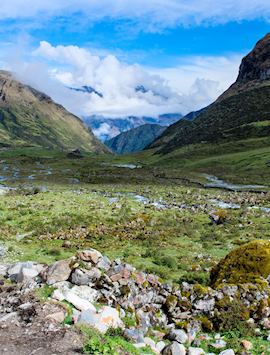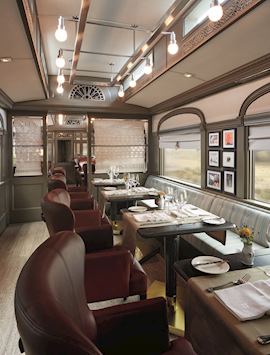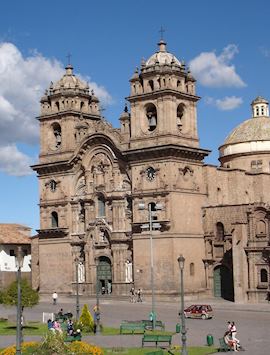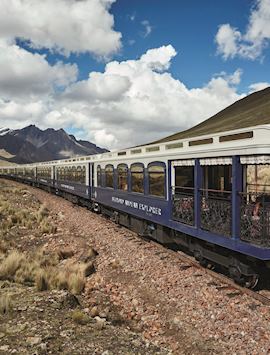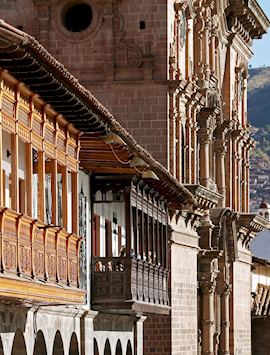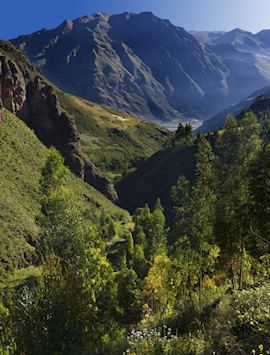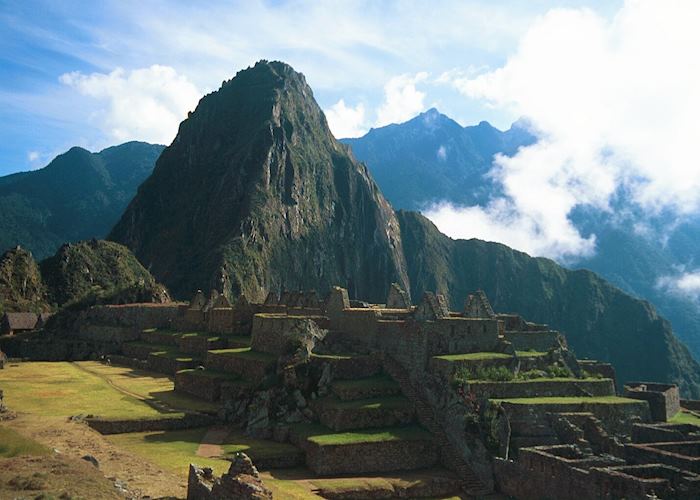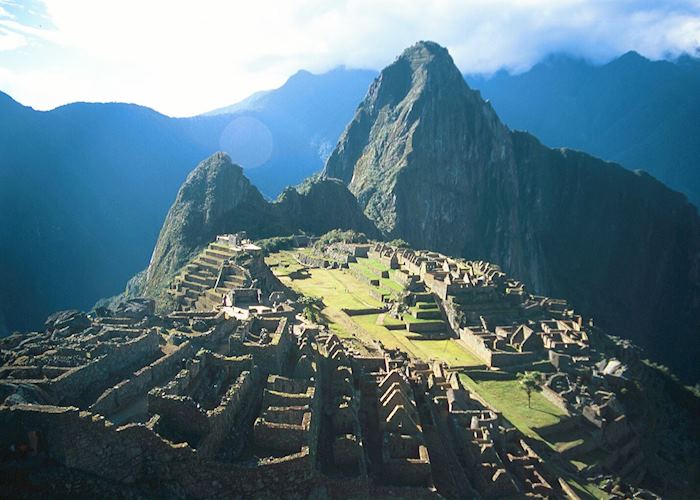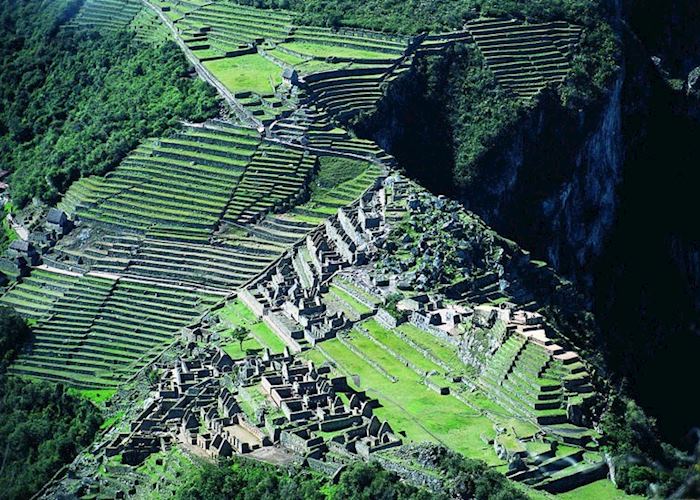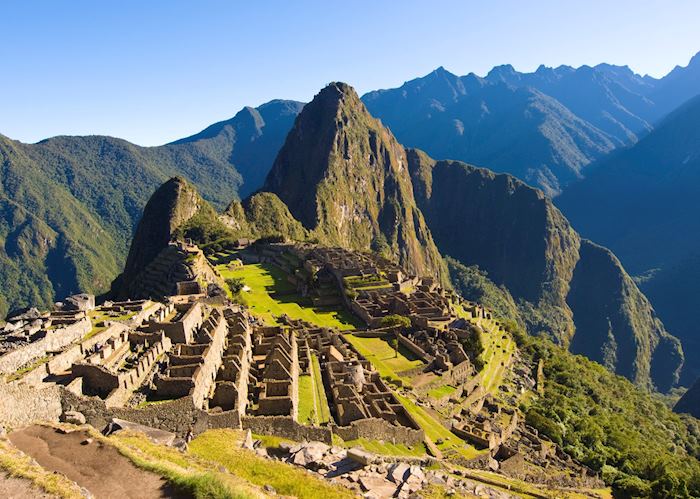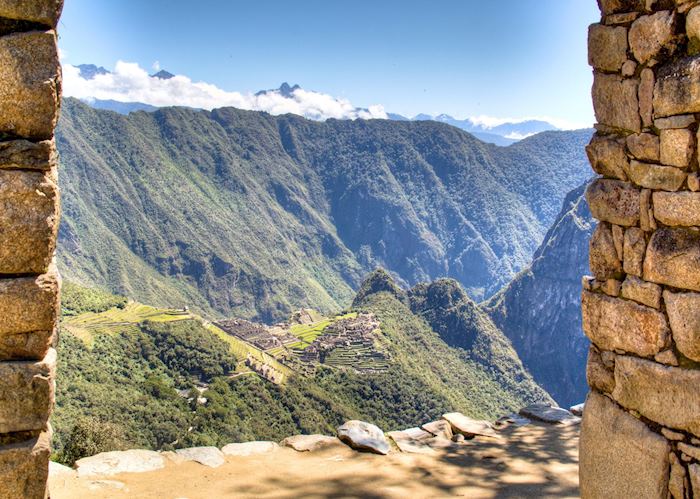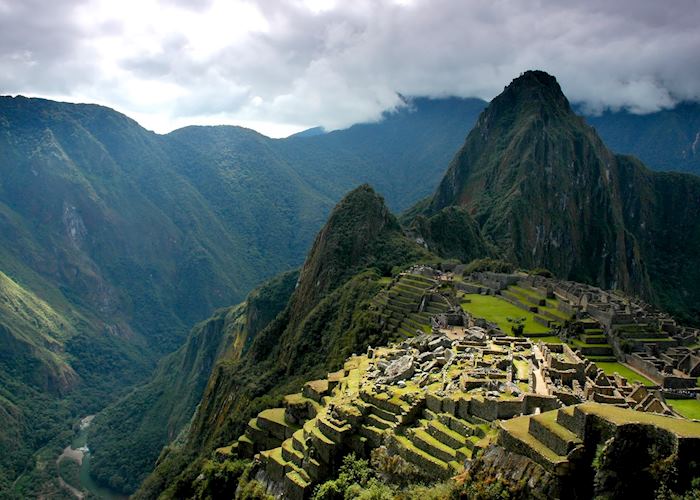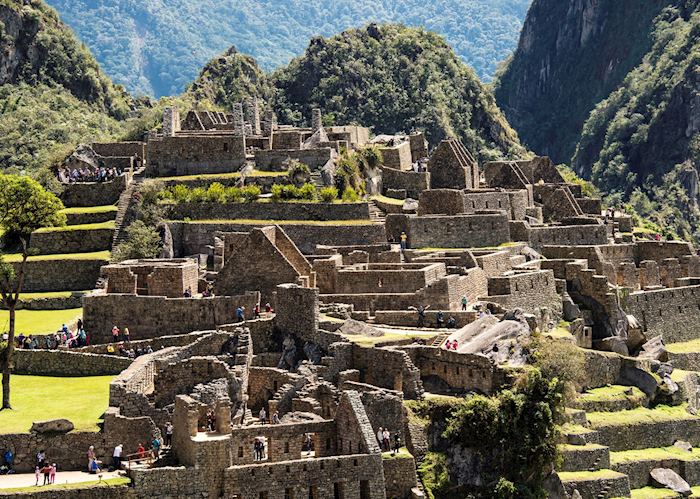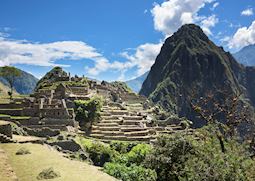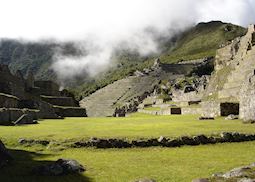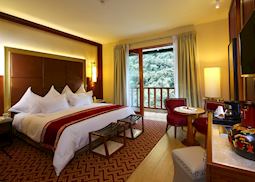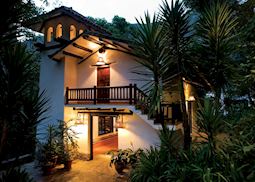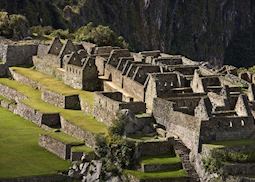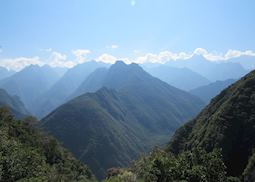Jump to:
A citadel suspended on a mountain saddle amid a great bowl of peaks, invisible to those approaching it from below on a winding series of switchbacks. Machu Picchu’s setting perhaps appeals most to the imagination, rather than the ruins themselves. Poised between two forested peaks are the shells of imposing palaces, temples, houses and storerooms, with many structures strategically positioned to line up with the sun.
Aside from a few llamas grazing the grassy terraces, and a viscacha (a rabbit-like rodent) or two snuggling in the empty window holes, the ruins are unadorned and devoid of any living presence (all the relics found there are displayed in a museum in Cuzco). Arrive there in the early morning, and you’ll see how the morning cloud gradually disperses into wisps, revealing the buildings and terracing layer by layer.
The site draws thousands of annual visitors, and permits require advance booking. However, Audley’s Peru specialists are also adept at recommending other Sacred Valley Inca ruins which are just as dramatic — but often virtually deserted.
Machu Picchu exceeds expectations: each time I go, I marvel at how and why it was built. No matter how many visitors you’re sharing the site with, you can still feel like you have the place to yourself.
Peru specialist Ella
Things to see and do at Machu Picchu
The Inca Trail
This three-day hike that traverses mountain peaks and Inca-laid paving is seen as the traditional, or most authentic, way to approach Machu Picchu: you’ll be treading the same route as the messengers who journeyed to and from the citadel.
Inca stonework
From their storehouses to their temples, the Incas seldom embellished their stone buildings with any carved decoration, and Machu Picchu is no exception. This didn’t diminish Hiram Bingham's impressions of the stonework, when he first reached the overgrown ruins of Machu Picchu on a winter's day in 1911. He described the stones as, 'beautifully fitted together in the most refined style of Inca architecture'.
The citadel's buildings are completely unostentatious, but you’re looking at the precision the Inca craftsmen achieved. You'd be hard-pressed to slot a credit card between any of the stones. Always building one step ahead of the next earthquake, Inca masons didn't simply lay standard-sized stones, one regular row on top of another. They used mortise and tenon joints to key many-angled blocks together across multiple faces. The Temple of the Three Windows serves as a particular good example of their mastery.
Terracing
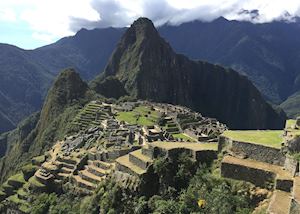 The scale of ambition at Machu Picchu is best illustrated in its agricultural terraces, which concertina down the mountainside like a giant's staircase. The cascading levels of walls drop acutely and are obscured from many vantage points around the complex, but their full length can be viewed at a side angle from the lower level of the complex, where the workaday buildings stand. The terraces are also laid bare in their full glory from the top of Huayna Picchu, where you can fathom just how big a part in the overall complex they play.
The scale of ambition at Machu Picchu is best illustrated in its agricultural terraces, which concertina down the mountainside like a giant's staircase. The cascading levels of walls drop acutely and are obscured from many vantage points around the complex, but their full length can be viewed at a side angle from the lower level of the complex, where the workaday buildings stand. The terraces are also laid bare in their full glory from the top of Huayna Picchu, where you can fathom just how big a part in the overall complex they play.
The Intihuatana and other astroarchaeology
Despite the Inca's pragmatic approach to building, there are a few sculptural details to look for at Machu Picchu. The ritualistic Intihuatana (‘hitching post of the sun’) stands on a highpoint of the complex, a tapered cuboid of stone protruding from a plinth that aligned with the sun. In the lower levels, two rings of stone, carved proud from the floor, are a more humble sign of the Inca’s interest in the heavens. They’re thought to have acted as instruments for gazing at the moon and stars when filled with water.
Temple of the Condor
Close by, the carving of a great bird in the Temple of the Condor is so rudimentary that it takes a bit of time to piece it together from what, ostensibly, looks like a triangle and a couple of crescents of stone. Once you have the whole, you’ll note that the Inca used the natural contours of two pieces of unworked stone for the great wings.
Walks to the Inca Bridge and the Sun Gate, or climb Huayna Picchu and Machu Picchu Mountain
Aside from Inca Trail, there are numerous paths within the grounds of the site, from a 20-minute diversion to the precarious-looking Inca Bridge to ascents of Machu Picchu Mountain or the more familiar, pointed peak overlooking the ruins, Huayna Picchu. Permits will need to be arranged for both of the peak climbs, while an hour’s round trip can bring you to the Sun Gate — thought to be the original entryway to the citadel.
Aguas Calientes
The frontier-like town situated in a gorge below the ruins can feel like little more than a stopping place, and some of its shops, eateries and places to stay ring true to that — service can feel perfunctory and bland. But it has its charms too, such as a series of hot springs, some murals, and (depending on which day you visit) local markets serving regional dishes.
Best time to visit Machu Picchu
We recommend visiting between April to October. Our specialists’ preferred time to visit is May, as the grass is springy and the mountainsides green. In May, you’re also more likely to avoid the rainfall that can beset the early months of the year, as well as the crowds that surge to the site in July and August.
who's been there
-
617-223-4521617-223-4920
- Make an inquiry
Suggested itineraries featuring Machu Picchu
Our itineraries will give you suggestions for what is possible when you travel in Machu Picchu, and they showcase routes we know work particularly well. Treat them as inspiration, because your trip will be created uniquely by one of our specialists.
Places near Machu Picchu
- Sacred Valley 15 miles away
- Cuzco 46 miles away
- The Southern Amazon 115 miles away
- Colca Canyon 172 miles away
- Arequipa 234 miles away
- Puno 251 miles away
- Paracas Nature Reserve 252 miles away
- Lake Titicaca 267 miles away
Photos of Machu Picchu
Our expert guides to exploring Machu Picchu
Written by our specialists from their own experiences of visiting Machu Picchu, these guides will help you make the most of your time there. We share both our practical recommendations and the best ways to appreciate Machu Picchu at its best.
-
Visit Machu Picchu: A first timer's guide ![Machu Picchu]()
Visit Machu Picchu: A first timer's guide
Visit Machu Picchu: A first timer's guide
Perched high on a mountain ridge and hidden from the world for hundreds of years, the ruins of Machu Picchu are the jewel in Peru's crown. One of our Peru specialists gives a personal account of how to get the most from your visit.
Read this guide -
Trekking to and around Machu Picchu ![Machu Picchu, Peru]()
Trekking to and around Machu Picchu
Trekking to and around Machu Picchu
Trekking to and around Machu Picchu offers walks to suit all abilities, from day hikes to multi-day treks. Peru specialist, Anna, picks some of her top choices, including the Inca Trail, Salkantay Trek and short walks from Machu Picchu.
Read this guide
Accommodation choices for Machu Picchu
We've selected a range of accommodation options for when you visit Machu Picchu. Our choices usually come recommended for their character, facilities and service or location. Our specialists always aim to suggest properties that match your preferences.
-
![Belmond Sanctuary Lodge, Machu Picchu]()
Belmond Sanctuary Lodge
Machu Picchu -
![Deluxe Room, Sumaq]()
Sumaq Hotel
Machu Picchu -
![Inkaterra Machu Picchu]()
Inkaterra Machu Picchu
Machu Picchu -
![Spa at El Mapi, Machu Picchu]()
El Mapi
Machu Picchu
Ideas for experiencing Machu Picchu
Our specialists seek out authentic ways to get to know the places that could feature in your trip. These activities reflect some of the experiences they've most enjoyed while visiting Machu Picchu, and which use the best local guides.
-
Tour of Machu Picchu ![Machu Picchu]()
Tour of Machu Picchu
Tour of Machu Picchu
Your tour of Machu Picchu will incorporate the Temple of the Sun, the Royal Tomb and the Intihuatana.
View details -
Day hike (KM 104 Trail) to Machu Picchu ![KM104]()
Day hike (KM 104 Trail) to Machu Picchu
Day hike (KM 104 Trail) to Machu Picchu
A trek from the Sacred Valley to Machu Picchu, arriving at the Inti Punku Sun Gate for an unforgettable view of Machu Picchu.
View details


